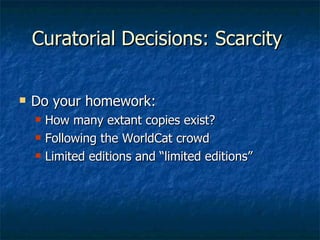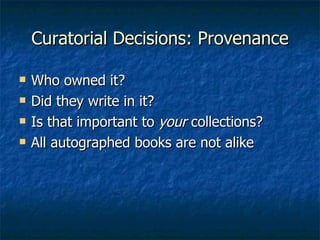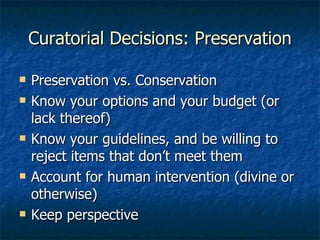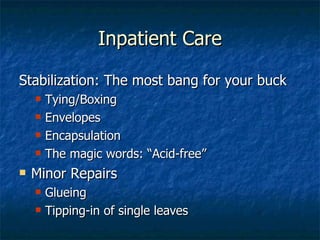Special Collections On A Shoestring
- 1. Special Collections on a Shoestring Lynne M. Thomas CARLI Preservation Working Group
- 2. Curatorial Decisions Every collection is different (and that’s ok). What is rare to me is not rare to you. Selection is part of preservation. Have a plan. Collection development guidelines ACRL Guidelines for transfer: http://www.ala.org/ala/acrl/acrlstandards/selectransfer.cfm What is the purpose of the collection? You can’t take everything. Don’t try to.
- 3. Curatorial Decisions What makes items eligible for Special Collections? Date Scarcity Provenance Condition Market Value
- 4. Curatorial Decisions: Date Before 1800 worldwide Before 1865 in United States Before 1890 West of the Mississippi River Regional/Global special collections need their own guidelines Your mileage may vary
- 5. Curatorial Decisions: Scarcity Do your homework: How many extant copies exist? Following the WorldCat crowd Limited editions and “limited editions”
- 6. Curatorial Decisions: Provenance Who owned it? Did they write in it? Is that important to your collections? All autographed books are not alike
- 7. Curatorial Decisions: Condition Condition is the single biggest factor in market value. Special Collections as a “dumping ground” for old items that can’t be repaired. Tape is evil. Mold is worse. Have firm guidelines about what you will say “no” to.
- 8. Curatorial Decisions: Market Value Find a ballpark value Ebay, Bookfinder.com, ABEBooks, ABAA.org Auction and bookseller catalog listings American Book Prices Current Have a baseline value for automatic transfer. Adjust baseline value periodically for market conditions and inflation.
- 9. Curatorial Decisions: Preservation Preservation vs. Conservation Know your options and your budget (or lack thereof) Know your guidelines, and be willing to reject items that don’t meet them Account for human intervention (divine or otherwise) Keep perspective
- 10. Preservation Options Ideal world vs. Reality In-house or on-site Off-site How do I pay for this?! Declaring an item “dead”
- 11. Ideal world vs. Reality Ideal world: Controlled environment No food or drink! Nobody touches the books but ME, buster… Reality Can we have our party here? Why can’t I have my bottle of water? Can I touch that book?
- 12. Preservation Options Inpatient care Environmental control Staff and patron education Stabilization Minor Repairs Outpatient care: time to see a specialist!
- 13. Environmental Control Turn off the lights! Keep your temperature and humidity as stable as possible Make friends with your building services folks
- 14. Staff and Patron Education Model good behavior Shelve and Unshelve properly Book props and book weights Photocopying and scanning practices Preservation photocopies Digitization projects Cool! Can we touch that?
- 15. Inpatient Care Stabilization: The most bang for your buck Tying/Boxing Envelopes Encapsulation The magic words: “Acid-free” Minor Repairs Glueing Tipping-in of single leaves
- 16. Outpatient care Major repairs: re-backing, re-binding Full conservation treatment: don’t try this at home! Finding a conservator American Institute for Conservation (AIC) guidelines: http://aic.stanford.edu/public/select.html
- 17. How do I pay for this? Find a donor/sponsor or a Friend Talk to your administration Get a grant IMLS http://www.imls.gov/ NEH Preservation assistance grants http://www.neh.gov/grants/guidelines/pag.html NEH Grants for Stabilizing Humanities Collections http://www.neh.gov/grants/guidelines/stabilization.html Guide to Foundation Grants for Preservation http://www.loc.gov/preserv/foundtn-grants.html
- 18. When it’s gone…it’s gone You can’t save everything. Really. Brittle books Mold “Rare” is not the same as “Unique” Can it be replaced if it can’t be repaired? Alternative formatting Preservation photocopies Digitization
- 19. Questions?



















